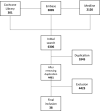The immunogenicity and safety of respiratory syncytial virus vaccines in development: A systematic review
- PMID: 33764693
- PMCID: PMC8189192
- DOI: 10.1111/irv.12850
The immunogenicity and safety of respiratory syncytial virus vaccines in development: A systematic review
Abstract
Background: Respiratory syncytial virus (RSV) is a leading cause of acute lower respiratory infection globally. There are vaccine candidates in development, but a systematic review on immunogenicity and safety of vaccine is lacking.
Methods: This systematic review of RSV vaccine clinical trials was undertaken using four databases. Searches were conducted using both controlled vocabulary terms such as "Respiratory Syncytial Virus, Human," "Respiratory Syncytial Virus Infections," "Respiratory Syncytial Virus Vaccines," "Immunization," "Immunization Programs" and "Vaccines" and corresponding text word terms. The included studies were limited to clinical trials published from January 2000 to 31 December 2020. RSV infection case was defined as RSV-associated medically attended acute respiratory illness (MAARI) or RSV infection by serologically confirmed test (Western blot) during the RSV surveillance period. We calculated the relative risk of each vaccine trial with RSV infection case.
Results: Of 6306 publications, 38 were included and data were extracted covering four major types of RSV vaccine candidates, these being live-attenuated/chimeric (n = 14), recombinant-vector (n = 6), subunit (n = 12) and nanoparticle vaccines (n = 6). For RSV infection cases, nine trials were involved and none of them showed a vaccine-related increased MAARI during RSV surveillance season.
Conclusion: LID ∆M2-2, MEDI M2-2, RSVcps2 and LID/∆M2-2 /1030s (live-attenuated) were considered the most promising vaccine candidates in infant and children. In the elderly, a nanoparticle F vaccine candidate and Ad26.RSV.preF were considered as two potential effective vaccines. A promising maternal vaccine candidate is still lacking.
Keywords: RSV promising vaccine; clinical trial; respiratory syncytial virus vaccine; safety and immunogenicity.
© 2021 The Authors. Influenza and Other Respiratory Viruses Published by John Wiley & Sons Ltd.
Conflict of interest statement
Professor Robert Booy: I work with all major manufacturers of vaccines in an advisory capacity, as a researcher on vaccines, as a presenter of academic information at conferences and also occasionally as an Advisory Board member. I receive support to travel and attend such conferences and meetings from the various pharmaceutical companies. On occasions, I also receive an honorarium which is paid direct to my institution. Any funding received is directed to a research account at The University of Sydney and is not personally accepted by myself. Other authors have no conflicts of interest.
Similar articles
-
Live Respiratory Syncytial Virus Attenuated by M2-2 Deletion and Stabilized Temperature Sensitivity Mutation 1030s Is a Promising Vaccine Candidate in Children.J Infect Dis. 2020 Feb 3;221(4):534-543. doi: 10.1093/infdis/jiz603. J Infect Dis. 2020. PMID: 31758177 Free PMC article. Clinical Trial.
-
Live-Attenuated Respiratory Syncytial Virus Vaccine With M2-2 Deletion and With Small Hydrophobic Noncoding Region Is Highly Immunogenic in Children.J Infect Dis. 2020 Jun 11;221(12):2050-2059. doi: 10.1093/infdis/jiaa049. J Infect Dis. 2020. PMID: 32006006 Free PMC article. Clinical Trial.
-
Live-attenuated Vaccines Prevent Respiratory Syncytial Virus-associated Illness in Young Children.Am J Respir Crit Care Med. 2021 Mar 1;203(5):594-603. doi: 10.1164/rccm.202005-1660OC. Am J Respir Crit Care Med. 2021. PMID: 32871092 Free PMC article.
-
Profile of respiratory syncytial virus prefusogenic fusion protein nanoparticle vaccine.Expert Rev Vaccines. 2021 Apr;20(4):351-364. doi: 10.1080/14760584.2021.1903877. Epub 2021 May 2. Expert Rev Vaccines. 2021. PMID: 33733995 Review.
-
The third pandemic: The respiratory syncytial virus landscape and specific considerations for the allergist/immunologist.Allergy Asthma Proc. 2023 Jul 26;44(4):220-228. doi: 10.2500/aap.2023.44.230030. Allergy Asthma Proc. 2023. PMID: 37236777 Review.
Cited by
-
Cationic-nanogel nasal vaccine containing the ectodomain of RSV-small hydrophobic protein induces protective immunity in rodents.NPJ Vaccines. 2023 Jul 24;8(1):106. doi: 10.1038/s41541-023-00700-3. NPJ Vaccines. 2023. PMID: 37488116 Free PMC article.
-
Intramuscular Inoculation of AS02-Adjuvanted Respiratory Syncytial Virus (RSV) F Subunit Vaccine Shows Better Efficiency and Safety Than Subcutaneous Inoculation in BALB/c Mice.Front Immunol. 2022 Jul 22;13:938598. doi: 10.3389/fimmu.2022.938598. eCollection 2022. Front Immunol. 2022. PMID: 35935960 Free PMC article.
-
Intranasal parainfluenza virus type 5 (PIV5)-vectored RSV vaccine is safe and immunogenic in healthy adults in a phase 1 clinical study.Sci Adv. 2023 Oct 27;9(43):eadj7611. doi: 10.1126/sciadv.adj7611. Epub 2023 Oct 25. Sci Adv. 2023. PMID: 37878713 Free PMC article. Clinical Trial.
-
Efficacy, Safety, and Immunogenicity of Subunit Respiratory Syncytial Virus Vaccines: Systematic Review and Meta-Analysis of Randomized Controlled Trials.Vaccines (Basel). 2024 Aug 2;12(8):879. doi: 10.3390/vaccines12080879. Vaccines (Basel). 2024. PMID: 39204005 Free PMC article. Review.
-
Identifying Cross-Utilization of RSV Vaccine Inventions across the Human and Veterinary Field.Pathogens. 2022 Dec 27;12(1):46. doi: 10.3390/pathogens12010046. Pathogens. 2022. PMID: 36678394 Free PMC article.
References
-
- Checchia PA, Nalysnyk L, Fernandes AW, et al. Mortality and morbidity among infants at high risk for severe respiratory syncytial virus infection receiving prophylaxis with palivizumab: a systematic literature review and meta‐analysis. Pediatr Crit Care Med. 2011;12(5):580‐588. - PubMed
-
- Falsey AR, Cunningham CK, Barker WH, et al. Respiratory syncytial virus and influenza A infections in the hospitalized elderly. J Infect Dis. 1995;172(2):389‐394. - PubMed
-
- Dowell SF, Anderson LJ, Gary HE Jr, et al. Respiratory syncytial virus is an important cause of community‐acquired lower respiratory infection among hospitalized adults. J Infect Dis. 1996;174(3):456‐462. - PubMed
Publication types
MeSH terms
Substances
LinkOut - more resources
Full Text Sources
Other Literature Sources
Medical


